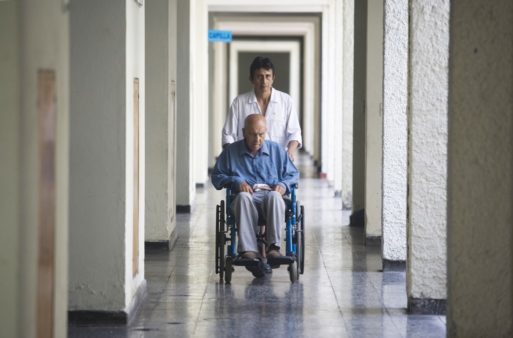A recent study shows that many U.S.nursing homes are providing unnecessary — and extremely lucrative — rehabilitation services to patients at the end of life. The rate of these “ultra-high intensity” services increased 65 percent between 2012 and 2015 in the population studied, according to a report in Eureka Alert. The study, led by Helena Temkin-Greener of the Department of Public Health Sciences, University of Rochester School of Medicine and Dentistry, was published in the Journal of American Medical Directors in October 2018.

Nursing home residents often receive therapy they neither need nor want
Credit: pbs.org
Temkin-Greener’s research team analyzed data from 647 nursing homes in New York State, focusing on those residents who received “very-high” or “ultra-high” levels of rehabilitation services, including speech, occupational or physical therapies, during their last 30 days of life. According to Medicare’s reimbursement schedules, the “very high” level of service is equal to at least 520 minutes of therapy per week or 75 minutes per day. The ultra-high service level is a minimum or 720 minutes per week, or at least two hours per day.
According to the study, for-profit nursing homes billed for the ultra-high level of service about two times as often as nonprofit facilities. This was especially true during the patient’s last seven days of life.
Gaming the System?
The use of high-intensity rehabilitation services at the end of life has been on the radar of government regulators for a number of years. Both the Centers for Medicaid and Medicare Services and the Office of the Inspector General have issued reports questioning the reasons behind the steep rise in these services, suggesting that for-profit facilities may be trying to maximize reimbursement rather than optimizing patient care.
These suspicions are supported by a look at Medicare’s reimbursement structure, which is based on categories known as resource utilization groups, or RUGS. These categories tie Medicare reimbursement to the amount of staff time needed to care for patients in each group. Patients who receive ultra-high intensity rehab qualify for the highest payments Medicare allows. According to a report from CMS, this translates to a six-times higher profit margin for the facility than when it provides low-intensity rehab to the same person.
“This study raises several concerns and questions regarding the scope and intensity of therapy provided to nursing home residents prior to death,” Temkin-Greener concludes. “If it is being driven by a failure to recognize that a resident is approaching end-of-life, then it calls for improving the skills of nursing home teams. If it is being driven by financial considerations, then regulatory and policy interventions may be necessary,” she writes.
Inappropriate Care
The study also points out that the use of high-intensity rehab is often incompatible with patient goals. For example, it cites an instance noted in the aforementioned OIG’s report of a hospice patient who received daily physical therapy for five weeks despite her requests that the therapy be stopped.

Credit: pinterest.com
More concerning still is the fact that the facilities which provide these high-intensity services may actually be doing their patients harm. According to Dr. Thomas Caprio, a geriatrician and hospice physician at the University of Rochester Medical Center, who co-authored the study, “These are often sick and frail patients in whom the risks of intensive levels of rehabilitation actually outweigh the benefits.” Further, intensive rehab may “increase the burden of pain and exhaustion experienced by patients and contribute to their suffering,” he said. Additionally and most importantly, the focus on rehab may create a barrier to the introduction of appropriate hospice or palliative care.
Policy Change Imminent
There may be a bright spot on the horizon, however, in the form of a significant change in Medicare policy regarding payments to nursing homes. According to Bloomberg, beginning Oct. 1, 2019, CMS will implement a new Patient-Driven Payment Model, which focuses on patients’ health status and care needs rather than the volume of care they receive. This policy change will “level the playing field so there won’t be the financial incentive to have therapy drive payment as much as it does today,” said Alan Tripp, of the nonprofit LeadingAge, which represents over 2,00 nonprofit nursing homes. However, Tripp admits that the actual impact of the change on patient care remains to be seen.

 High-Intensity Rehabilitation Services Overused in Nursing Homes, Study Shows
High-Intensity Rehabilitation Services Overused in Nursing Homes, Study Shows


 “Help Me, Helen”
“Help Me, Helen”

 “As Tears Go By” by Marianne Faithfull
“As Tears Go By” by Marianne Faithfull














